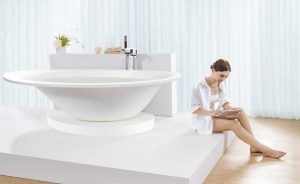Table of Contents
Everyday use of acrylic bathtubs results in the accumulation of dirt, bacteria, and soap scum. Someone may raise the question of how to clean a plastic bathtub or acrylic bathtub. To clean grout, and remove mold and stains from the bathtub, it is recommended to use cleaning supplies that cause no abrasion to the tub.
Knowing the type of bathtub surface – acrylic, fiberglass, enamel, or porcelain – is crucial for effective cleaning. Keeping your bathtub clean is essential to protect your family from infecting potentially harmful bacteria. This article provides instructions on how to clean your bathtub and remove stubborn stains from its surface.
Cleaning Tips for Acrylic Bathtubs
A regular cleaning activity of your bathtub will enable you to reduce the time spent on cleaning from about one hour twice a year to just 10 minutes every month. Additionally, cleaning soap residue on the bathtub can help maintain the grout and glass clean for a longer period.
It is not advisable to clean your acrylic bathtub using traditional methods such as using acetone treatment or steel wire balls since these methods may harm the surface of the bathtub. To ensure that you clean and maintain your tub properly without damaging it, you could apply safer products such as baking soda, white vinegar, borax powder, and shampoo.
These products are not only safe for the tub, but also for your skin. To learn more about how to use these safe products to clean your acrylic bathtub effectively, let’s explore the details further.
Things You Should Do When Cleaning Your Acrylic Tub
When it comes to the question of how to clean your acrylic bathtub, there are a few things you should keep in mind to ensure that the tub remains clean and undamaged:
1. Use a soft sponge or cloth
Instead of using steel wool or abrasive materials, use a soft sponge or cloth to clean the tub. This will help prevent scratches and damage to the surface of the acrylic. To lightly clean the surface, a dish sponge or a soft towel dipped in hand soap or dish soap is advisable.
2. Use safe cleaning products
As mentioned earlier, it is best to use safe products such as baking soda, borax powder, shampoo, and white vinegar to clean your acrylic bathtub. Don’t use harsh chemicals such as bleach and ammonia that could severely damage the surface.
Sprinkle some baking soda or a gentle cleaning product all over the bathtub, leave it there, and wait for 5 to 10 minutes. Baking soda is effective in eliminating stubborn grime from acrylic.
As for persistent stains, use warm water and vinegar to fill the bathtub, let the mixture soak for 15 minutes or longer to break down any mildew or dirt, and then empty the water. A clear bathtub will appear.
3. Rinse thoroughly
After cleaning the tub, make sure to rinse it thoroughly with warm water. This will help remove any remaining dirt or cleaning product residue. Remember to wear rubber gloves to protect your hands.
Since some chemicals can cause discoloration and harm to your clothing, it’s advisable to wear old clothes when cleaning the bathtub. It should be pointed out that you’d better conduct a small patch test of the cleaning product on an inconspicuous area before applying it to the entire tub’s surface.
This will enable you to determine whether the cleaning product is entirely safe and won’t cause any damage to your bathtub.
4. Dry the tub
Use a clean, dry cloth to dry the tub after cleaning. This will help prevent water spots and streaks from forming on the surface of the acrylic.
Things to Avoid When Cleaning The Acrylic Bathtub
There are correct and incorrect ways to clean an acrylic tub. Choosing the appropriate cleaning supplies can prolong the bathtub’s lifespan and ensure that it always appears immaculate and shiny. Here are some things to avoid when cleaning an acrylic bathtub:
1. Abrasive cleaners
Avoid using abrasive cleaners like scouring pads or abrasive powders, as they can scratch the surface of the tub. Instead, use a mild cleaner like dish soap or a specially formulated acrylic cleaner.
2. Harsh chemicals
Avoid using harsh chemicals like bleach or ammonia, as they can cause the surface of the acrylic bathtub to become discolored and damaged. Instead, use a mild cleaner that is specifically formulated for use on acrylic surfaces. Bleach acknowledged as a potent disinfectant has the potential to harm and discolor your bathtub.
Moreover, it can cause significant damage to your skin, and inhaling its fumes is hazardous. It’s crucial to avoid combining this chemical with other cleaners as it can result in the creation of toxic gases. Mixing chlorine bleach and ammonia could result in skin burns. Remember that blending chemicals can be extremely hazardous, particularly if you lack adequate knowledge of the subject.
3. Steel wool
Avoid using steel wool or other abrasive materials to clean your acrylic bathtub, as they can scratch the surface of the tub. Instead, use a soft sponge or cloth.
4. High heat
Avoid using hot water to clean a tub, as high temperatures can damage the surface. Instead, use warm water and a mild cleaning solution.
Maintaining Your Acrylic Bathtub
It is a common misconception among homeowners that an acrylic bathtub only needs to be cleaned when discoloration is visible. However, it is advisable to clean the tub regularly, at least once a week, to avoid the buildup of soap scum, grime, and dirt, which can be difficult to remove later on.
Regular rinsing after each use can also help reduce buildup and prevent mildew while removing toys from the tub can prevent watermarks on the acrylic surface. It is vital to clean all corners of the bathtub regularly. Maintaining a neat and shiny bathtub is not as hard as you may think. Just following proper care instructions and maintenance, an acrylic bathtub can maintain its convenience, beauty, and durability for many years.
LESSO acrylic bathtub could bring you much more convenience of use and maintenance due to its good design and high quality. For more information, please visit the official website of LESSO.


Bath VS Shower, Which is Better?
Table of Contents To bath or to shower, that’s a question. Deciding between the two can be a challenging task for many homeowners because they


How to Choose the Best Bathtub
Table of Contents The best bathtub material for a lightweight which is easy to clean and inexpensive is fiberglass while porcelain-enameled cast iron is the








